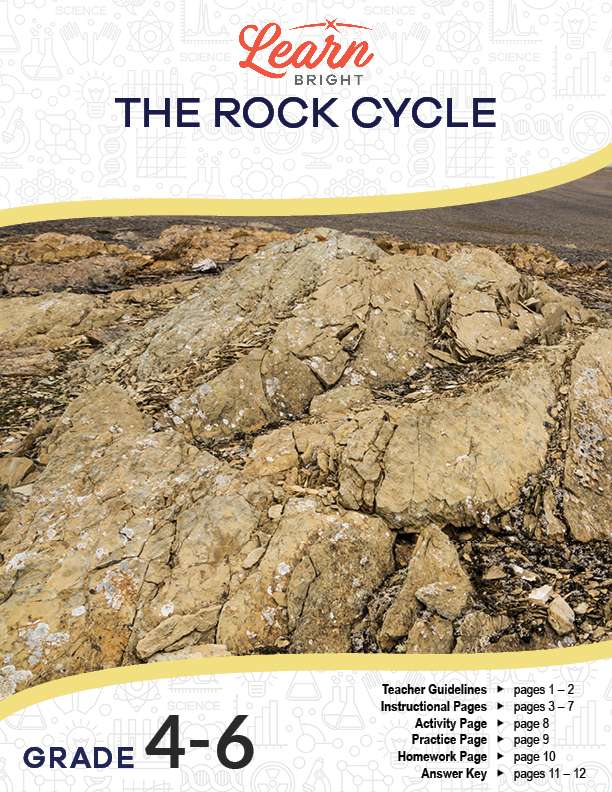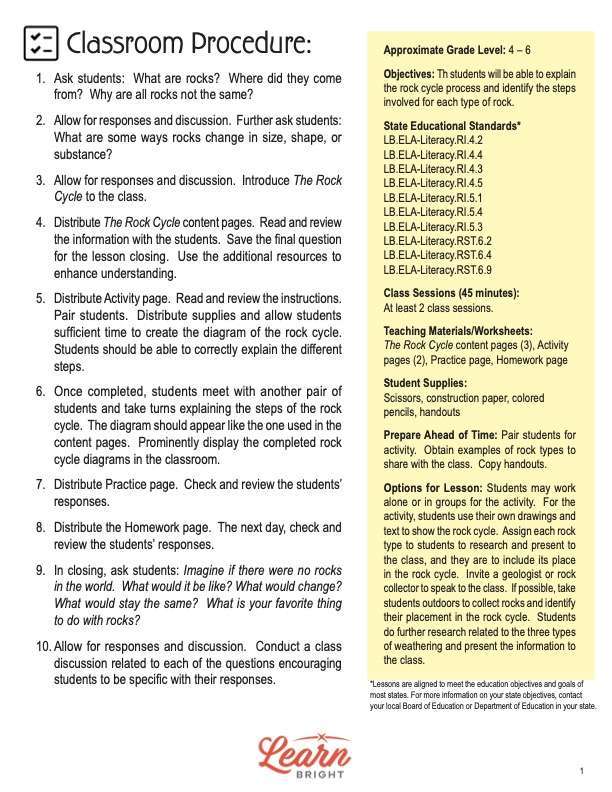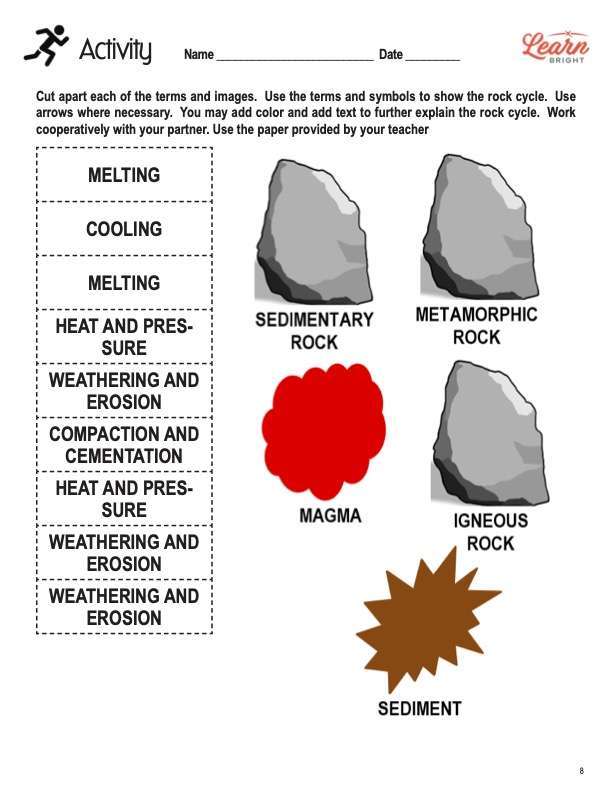Description
What our Rock Cycle lesson plan includes
Lesson Objectives and Overview: Rock Cycle introduces students to the process in which rocks change into different types over time. There are three types of rock, and each type develops during some part of the cycle. Students may have learned what the three types of rocks are already. However, they may still not know how they are formed or how long it takes to transform. The lesson describes each rock and how it forms throughout the process. This lesson is for students in 4th grade, 5th grade, and 6th grade.
Classroom Procedure
Every lesson plan provides you with a classroom procedure page that outlines a step-by-step guide to follow. You do not have to follow the guide exactly. The guide helps you organize the lesson and details when to hand out worksheets. It also lists information in the yellow box that you might find useful. You will find the lesson objectives, state standards, and number of class sessions the lesson should take to complete in this area. In addition, it describes the supplies you will need as well as what and how you need to prepare beforehand. This lesson plan requires that you provide scissors, construction paper, and colored pencils in addition to the handouts. To prepare ahead of time, collect rock samples if you can of the three different rock types.
Options for Lesson
The “Options for Lesson” section lists a number of suggestions for additional tasks or alternatives for the lesson. For the activity, students could use their own drawings and text to show the rock cycle rather than the images and labels on the worksheet. You could assign each rock type to students to research and later present to the class. The students would need to include the rock’s “place” in the cycle as part of their presentations. Another option is to invite a geologist or rock collector to speak tot he class and answer questions. If possible, you could take students outside to collect and identify rocks and where they fall in the rock cycle. One more idea is for students to further research the three types of weathering and present what they discover to the class.
Teacher Notes
The paragraph on the teacher notes page explains a little more about what to expect from the lesson plan. While students may know the three types of rocks, they may not fully understand how the cycle works or how much time passes between stages. You may benefit from teaching this lesson in conjunction with others that relate to rocks, weathering and erosion, and so on.
ROCK CYCLE LESSON PLAN CONTENT PAGES
Igneous, Sedimentary, Metamorphic Rocks
The Rock Cycle lesson plan has five pages of content. Rocks come in many shapes, sizes, and colors and exist at the tops of mountains to the bottoms of oceans. Some are soft, some are sharp, and some are light. Students will discover that despite how many rocks there are in the world, they all fall into one of three categories: igneous, sedimentary, or metamorphic.
Igneous rocks are basically the result of hardened magma that forms either below or above ground. They don’t contain any fossils or organic matter. Builders often use these types of rocks for building and construction because they have such strong properties.
Sedimentary rocks form from compacted sediment that can come from other types of rocks that eroded or from the remains of living things. These rocks can turn back into sediment. They are rather soft and appear most often in layers, which geologists call strata. In addition, people can pressurize them to convert them into metamorphic rock.
Finally, metamorphic rocks are the least common. They form from igneous and sedimentary rocks that have undergone extreme heat and pressure. When rock beds shift and move, it squeezes the rocks and places them under pressure. Along with extreme heat, the pressure causes chemical changes in the rock.
Students will then learn discover that, although the different types of rocks within each category are unique, they all have a few common traits or properties. For one thing, they undergo a variety of physical processes, including cooling, melting, weathering, compacting, and cementing. Over time, they all endure changes that turn them from one type of rock to another. Finally, all rocks will eventually go through the rock cycle. The processes may occur in a different order, but the cycle will continue forever.
Steps of the Rock Cycle
Several Earth cycles occur simultaneously with the rock cycle—the water cycle, nitrogen cycle, carbon cycle, and more. And like all of Earth’s cycles, the rock cycle is continuous, and its steps are not always in the same order. Through this process, rocks of one kind (one of the three main classes) change into another. It is essentially the journey a rock takes as it changes, and this change takes place over a very long period, sometimes millions of years.
The lesson describes the six main steps of the cycle. In one step, magma cools and crystallizes under the earth’s crust, forming intrusive igneous rocks. With time, pressure causes uplift that causes the rocks to end up on the surface. During another step, molten magma flows to to surface as lava due to volcanic activity. This creates extrusive igneous rocks as the lava hardens and crystallizes. Weathering, erosion, and movement of rock on the surface carry sediment to low-lying places and water bodies through another step of the cycle.
Similarly, sedimentary rocks form in another step as sediment piles up and compacts, cementing the rocks in place. After a long period of high pressure and heat, igneous and sedimentary rocks buried deep in the crust change into metamorphic rocks. Throughout the last step, some of the metamorphic rocks melt as they get close to molten magma. Some uplift to the surface, and if they melt, they release again through volcanic activity. All of these steps occur simultaneously in no particular order, and will continue to do so throughout time.
Weathering and Erosion
In some places, weathering and erosion occurs more often than in other. Erosion is an important factor in the rock cycle because it moves weathered rocks from one place to another by wind, ice, water, or gravity. In other words, natural elements move weathered pebbles, sand, and soil to other places. The three types of weathering that break down rocks are physical, chemical, and biological.
Physical weathering includes wind, water, waves, and temperature changes. Rocks heat up and cool off, which makes them expand and contract. This causes the rocks to crack. Layers of rock wear off as well during a process scientists call exfoliation.
The next type of weathering students will learn about is chemical weathering. This involves the reaction of some chemicals on rocks that are prone to breaking down when exposed to those chemicals. Rainwater, for instance, can be acidic, and acid rain can break down certain rocks for this reason. Air pollution is another example of chemical weathering.
Finally, biological weathering occurs when animals or other living things affect the rocks they encounter. When animals burrow into a crack in a rock, the crack widens and eventually causes the rock to break apart. Algae, bacteria, and mosses that grow on the surfaces of rocks produce weak acids that eventually break the rocks apart. Plant roots can also get into cracks. And, of course, humans can cause weathering through construction and other activities.
Key Terms
Here is a list of the vocabulary words students will learn in this lesson plan:
- Magma—the liquid rock beneath a volcano
- Strata—another name for layers of rock
- Rock Cycle—the steps that rocks undergo to change from one type of rock to another
- Lava—the name for magma that exited a volcano and flows along the earth’s surface after an eruption
- Sediments—pieces of sand, dirt, dead animals, and other matter that move around due to weathering and erosion
- Erosion—the process of moving weathered rock or sediment from one place to another by wind, ice, water, and gravity
ROCK CYCLE LESSON PLAN WORKSHEETS
The Rock Cycle lesson plan includes three worksheets: an activity worksheet, a practice worksheet, and a homework assignment. Each one helps reinforce students’ comprehension of the lesson content. You can refer to the guide on the classroom procedure page to determine when to give students the handouts throughout the lesson.
DISPLAY THE CYCLE ACTIVITY
Each student will cut apart the terms and images on the activity worksheet. They will have to arrange them to illustrate the cycle. The lesson suggests they add text and color to explain certain areas further. You can divide the students into pairs or groups if you want for this activity.
ROCK CYCLE PRACTICE WORKSHEET
The practice worksheet contains three different sections. First, students will mark the steps of the rock cycle in order. Second, they will match each statement—there are eight total—to the type of rock: sedimentary (S), igneous (I), or metamorphic (M). Last, they will fill in the blanks of a paragraph using the word bank.
ANSWER AND DEFINE HOMEWORK ASSIGNMENT
The homework assignment splits into two sections. The first section lists 10 question, three of which are true or false. The second section lists 10 definitions. Students must match the definition to the correct term on the right.
Worksheet Answer Keys
The last two pages of the document are answer keys for the practice and homework worksheets. All the correct answers are in red to make it easy to compare them with the students’ worksheets. If you choose to administer the lesson pages to your students via PDF, you will need to save a new file that omits these pages. Otherwise, you can simply print out the applicable pages and keep these as reference for yourself when grading assignments.










